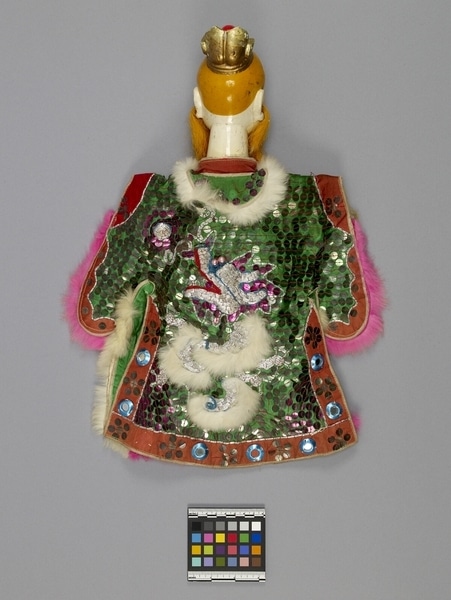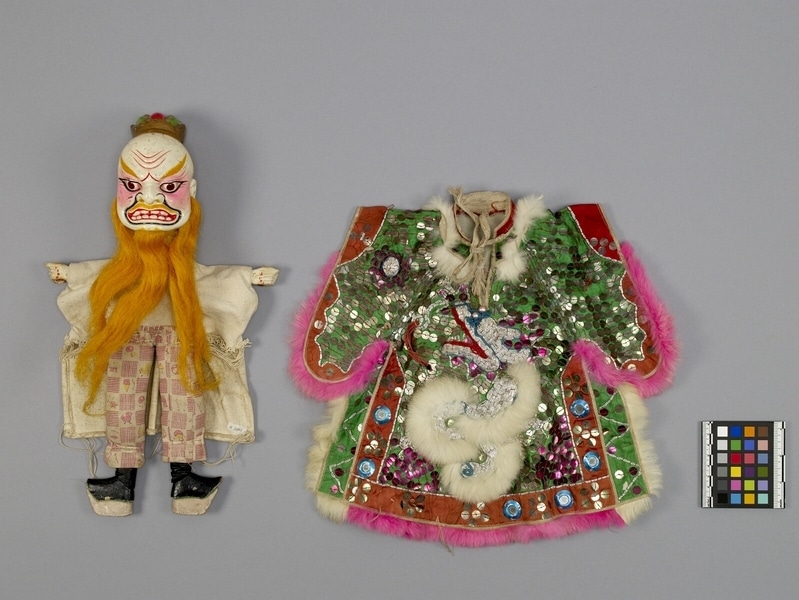Hand Puppet Item Number: Ia60 a-b from the MOA: University of British Columbia




Description
Costumed cloth hand puppet with carved, painted wooden head, hands and feet. Represents character of Old Male (aggressive, with Daoist headgear and magical powers), Golden Rays style. Varnished white face, pink cheeks, yellow hair, gold, green and red crown. Black, yellow and red details on face. Yellow dyed hair beard attached at slits in chin. Body (part a), undyed cotton flaps, attached around head, attached white hands with holes through sideways, partially stuffed with paper, stuffed legs of pink and yellow patterned cotton, attached white and blue-green soled black boots. Pasted and stitched green silk robe (part b), orange and red silk border, green silk at front side edges, also inside front. Decorations include blue tin edged mirrors, red and green plastic sequins, white and pink fur trim. Centre front and back design of dragon in multiple rows of silver foil wrapped thread, pink plastic 'pearl' eyes, red and blue cord. Wrapped thread circle to upper left of centre. Detachable robe attached with cord at neck. Legible purple characters in oval on puppet flap.
History Of Use
Chinese hand puppet theatre continues to be an active form of popular entertainment in Taiwan. In general, it has a long (over 2,000 years) history which reached a peak of activity during the Qing Dynasty. By then Fukinese hand puppet theatre had reached Taiwan and by 1900, five hundred troupes were touring the island, playing during seasonal festivals, religious celebrations, birthdays, weddings and banquets. Traditionally, 7 men made up a troupe, 2 to manipulate the puppets and speak the roles, and 5 musicians to provide accompaniment and sound effects. Plots are adapted from novels, fairy and folk tales, history and from supernatural events. Short comic scenes opened the presentation, followed by long plays. By 1900, in Taiwan, puppet theatre began taking on distinctive Taiwanese traits, and after the outbreak of the Sino-Japanese War, Fukinese puppets were no longer imported. Puppets became larger (closer to 50 cm) and less finely carved. Costumes are patterned on Ming Dynasty (1368-1644) dress, and the iconographic style often follows Chinese opera.
Cultural Context
Used in puppet theatre performances.
Narrative
Transcription of legible characters reads: line 1; xiang xin pu; line 2; (too faint) zhong zhang lo. The first line appears to give the locality and the second line, the name of the puppet troupe (Graham Johnson, p.c.).
Iconographic Meaning
Puppet: white face and pink cheeks signify nobility and honor (malkin). The large, open mouth suggests a bellicose nature (ucla). Crown suggests royalty. Costume, silver dragon, symbolizes royalty.
Item History
- Made in Taiwan before 1950
- Owned by Dorian Rae before October 31, 1980
- Received from Museum of Anthropology Shop Volunteers (Funding source) and Dorian Rae (Seller) on October 31, 1980
What
Who
- Culture
- Taiwanese
- Previous Owner
- Dorian Rae
- Received from
- Museum of Anthropology Shop Volunteers (Funding source) and Dorian Rae (Seller)
Where
- Holding Institution
- MOA: University of British Columbia
- Made in
- Taiwan
When
- Creation Date
- before 1950
- Ownership Date
- before October 31, 1980
- Acquisition Date
- on October 31, 1980
Other
- Condition
- fair
- Accession Number
- 0677/0004